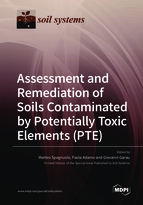Assessment and Remediation of Soils Contaminated by Potentially Toxic Elements (PTE)
A special issue of Soil Systems (ISSN 2571-8789).
Deadline for manuscript submissions: closed (31 January 2022) | Viewed by 31333
Special Issue Editors
Interests: potentially toxic elements; X-ray spectroscopic techniques; synchrotron techniques; solidification/stabilization; bioavailability and bioaccessibility; biomarkers; bioindicators; ecotoxicity
Interests: soil contamination; potentially toxic elements; speciation; sequential extractions; bioavailability; bioaccessibility; microscopical and microanalytical techniques
Interests: PTE-polluted soils; PTE mobility, toxicity, and bioavailability; impact of PTE on the structure and function of soil microbial communities; soil enzyme activity; use of amendments for the recovery of PTE-polluted soils; assisted phytoremediation
Special Issue Information
Dear Colleagues,
Potentially toxic elements (PTE) can cause significant damage to the environment and human health in function of their mobility and bioavailability. Given the urgency to remediate polluted soils all over the world, appropriate innovative and sustainable remediation strategies need to be developed, assessed, and promoted.
Before that, a detailed knowledge of PTE bioavailability and bioaccessibility as well as of soil processes affecting the contaminant dynamics in terms of lixiviation, colloidal transport, redox conditions, or microbial activity is essential in order to assess the actual danger/risk posed by contamination. It is widely recognized that bioavailability of toxic elements in soils depends on their solubility and geochemical forms, rather than on their origin and total concentration. Therefore, the knowledge of their spatial distribution and chemical speciation in soil is of paramount importance to perform an accurate risk assessment. Investigating these aspects requires the use of analytical techniques able to solve the high complexity of the soil matrix with a spatial resolution down to the micrometer- or even nanometer-scale.
In addition, a correct evaluation of a remediation intervention requires a detailed knowledge of the geochemical forms into which PTE have been converted following the soil treatment. This information is crucial to predict any possible transformation PTEs might naturally undergo over time or as consequence of physical-chemical perturbations that might impact the soil system.
The aim of this Special Issue is to address all the above reported aspects, i.e., the assessment of PTE contamination in soil systems using innovative approaches, the study of soil processes affecting pollutant dynamics and the application of new sustainable remediation techniques for the long-term reduction of the threat posed by PTE towards the health of the environment.
Dr. Matteo Spagnuolo
Prof. Dr. Paola Adamo
Dr. Giovanni Garau
Guest Editors
Manuscript Submission Information
Manuscripts should be submitted online at www.mdpi.com by registering and logging in to this website. Once you are registered, click here to go to the submission form. Manuscripts can be submitted until the deadline. All submissions that pass pre-check are peer-reviewed. Accepted papers will be published continuously in the journal (as soon as accepted) and will be listed together on the special issue website. Research articles, review articles as well as short communications are invited. For planned papers, a title and short abstract (about 100 words) can be sent to the Editorial Office for announcement on this website.
Submitted manuscripts should not have been published previously, nor be under consideration for publication elsewhere (except conference proceedings papers). All manuscripts are thoroughly refereed through a single-blind peer-review process. A guide for authors and other relevant information for submission of manuscripts is available on the Instructions for Authors page. Soil Systems is an international peer-reviewed open access quarterly journal published by MDPI.
Please visit the Instructions for Authors page before submitting a manuscript. The Article Processing Charge (APC) for publication in this open access journal is 1800 CHF (Swiss Francs). Submitted papers should be well formatted and use good English. Authors may use MDPI's English editing service prior to publication or during author revisions.
Keywords
- Potentially toxic elements
- Soil contamination
- Risk assessment
- Bioavailability
- Bioaccessibility
- Soil processes
- PTE distribution patterns
- Spectroscopic techniques
- Speciation techniques
- PTE stabilization
- PTE phytoextraction
- Phytoremediation








